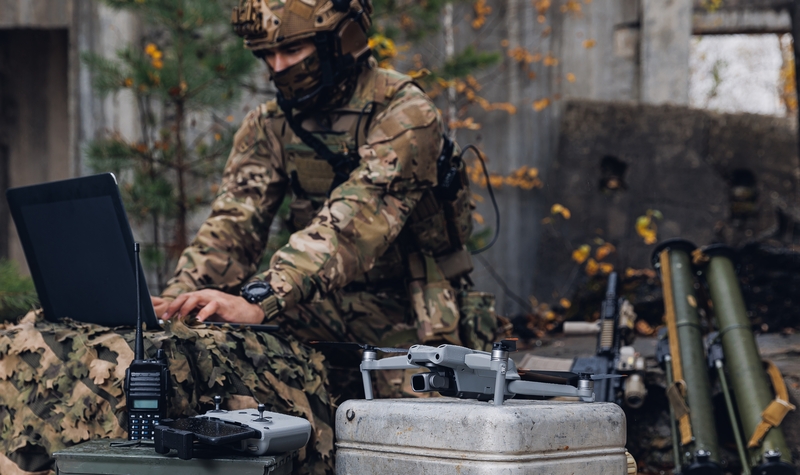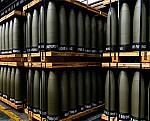An era of geopolitical changes, uncertainties, conflicts, but also the development of technology
The military conflict in Ukraine has recently been marked by the ubiquitous unmanned aerial vehicles/drones, which not only provide up-to-date situational awareness on the battlefield, but are capable of immediately destroying enemy combat equipment and personnel upon detection of enemy targets. In addition to using drones during defense and offense, drones are also used to engage targets in the enemy's rear. In the context of this widespread use of drones and their mass deployment, new conditions for conducting combat operations are also being created.

With the involvement of other technologies such as artificial intelligence (AI), the capabilities of drones will continue to evolve. In addition to their stated uses, the prerequisites for deploying them against enemy drones are also evolving (by destroying them on impact, dropping a capture net, but one can also imagine eliminating them by firing a projectile or jamming the guidance system or taking control).
In view of these developments, the concealment of unit and equipment activities is becoming increasingly important, including the location of important objects, in particular command posts, ammunition and fuel depots, but also firing positions, elements of air defence systems, etc. If enemy positions are detected, the most vulnerable are those that cannot be easily and quickly relocated and do not have sufficient protection. Such targets in the context of the conflict in Ukraine include
such as factories or energy infrastructure. Cyber-attacks then primarily target the internet networks of banking and government institutions.
Both sides in the conflict seek to identify such targets, the destruction of which will cause the enemy a tangible loss. The subsequent use of such successes for propaganda purposes also plays a role. The associated psychological effects will not only affect the soldiers on the battlefield, but will also affect the morale and attitudes of the civilian population.
In addition to drones, the use of artillery, including rocket-propelled grenade systems, continues to have a devastating effect. Precision-guided, long-range cruise missiles, which can be fired from, for example, the US HIMARS rocket launcher, are one of the options available to the Ukrainian army to deal a significant blow to Russia.
However, like other modern and sophisticated systems, these means are not cheap, including the ammunition used. As with, for example, Patriot air defense systems, the cost of HIMARS missile launchers will be a limiting element for their quantitative deployment in the conflict. Russia has also had to respond to the enormous consumption of munitions, including expensive cruise missiles, by developing war production, and estimates of production not only of munitions are important data for further predicting the expected evolution of the situation on the battlefield, but also possible political steps to end the conflict.
How to defend against drones?
One measure will be to camouflage and deceive, and thus actually protect against detection or correct assessment of targets as a precaution. It will not only be stationary objects, but also preparations for operations of various scales.
Immediate defence against drones can involve a wide range of measures and therefore means. First and foremost, these will be means for detection and identification. Then comes the actual elimination of the threat, ideally in a cheap and as accessible way as possible (e.g. by using a primary weapon - a cannon with programmable ammunition in the case of BVP, etc.).
The next trend in future operations, also with regard to the effectiveness of weapon systems, their development and quantitative increase, will be the effort to reduce casualties. In addition to the aforementioned camouflage and deception, another feature of combat activity may be the conduct of well-prepared small-scale operations where larger concentrations of equipment and live forces will be more difficult to detect.
Possible trends in the conduct of operations
Both sides in a conflict learn from each other, as evidenced by the war in Ukraine. Sometimes a successful tactic by one side can subsequently be used by the other side. This is also why some successful actions are accompanied by misleading information in order to conceal how they were carried out. Also based on the experience gained, both sides will seek to align prepared forces and assets as effectively as possible to increase the chances of surprising the enemy and giving him as little time as possible to take countermeasures. If the offensive operation develops favourably, the deployment of additional reserves can also be envisaged to further assess the breaching of the defences. As always, the nature of the terrain, the enemy's fortification and barricading measures, or the weather will be taken into account by both sides. And increasingly, the threat of deploying enemy drones, which can not only detect the enemy in time but also attack them by surprise, will have to be reckoned with. Using these means can change the balance of power on the battlefield in a very short time.
In the context of financial costs, but also the possibility of rapid production or further development, the mass use of low-cost drones can have a significant impact on the future direction or outcome of a conflict.
Currently, the Ukrainian military is largely dependent on unpredictable foreign assistance to plan its military operations. This is evident in the supply of ammunition. In general, it can be assumed that in the case of limited ammunition resupply options, both sides will try to use it as efficiently as possible.
The limited resources and possibilities of importing the necessary military equipment in times of armed conflict underline the importance of building up own production capacities, and therefore of promoting cooperation with the domestic defence industry, schools, training centres and ensuring rapid implementation of the latest experience, including technological developments.
The considerable costs associated with the long-term conduct of combat operations may affect the initial objectives and assumptions for the future development of the conflict. The cost and ease of production of weapon systems may be one important prerequisite for gaining decisive superiority.
The ability to adapt to a changing situation (use of new technologies and weapon systems, tactics chosen to take into account terrain, weather and enemy capabilities) will also be an important factor in the success of operations on both sides. For example, the use of "primitive" and cheap missiles or drones may gradually weaken the enemy's air defence, not to mention the financial disparity to the detriment of cruise missiles designed to shoot down these assets.
Further, the further development of the conflict and the situation on the battlefield may be influenced, for example, by the expansion of the front line, which may favour the attacking side, especially if it has sufficient reserves.
Related impacts
By slowing down military operations, the Russian leadership may not only seek to reduce the losses of the attacking forces, but may also be betting on the weakening of the role of the West in the geopolitical order of the world. It cannot be ruled out that part of this strategy will be to try to burden Western countries with new conflicts, migration, radicalisation of their populations or weakening of their economies.
The proliferation of armed conflicts in the world may accelerate shifts in the geopolitical position of dominant states, or entire military-political blocs and economic groupings. In the worst case, however, it could lead to global conflict, which is probably not the wish of those who profit from wars.
A significant risk from this point of view is a further escalation of tensions in the world, which may reach a point where it will be impossible to reverse this dangerous development.










